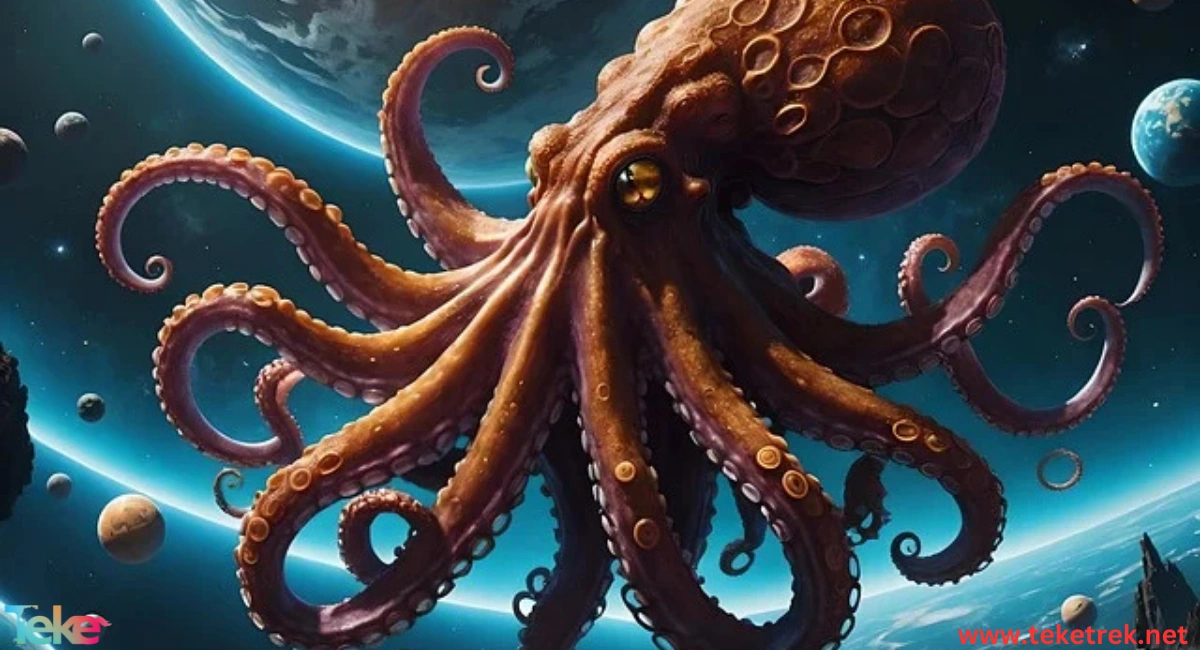Octopuses:
Mysterious and Fascinating Marine Creatures
Octopuses are among the most captivating and intriguing marine creatures. They possess unique features and exhibit mysterious behaviors. Belonging to the class Cephalopoda, octopuses are part of the mollusk family and are some of the largest known mollusks.They are also able to change color and adapt to their surroundings.
Let’s learn more about it from teketrek.

Scientific Classification and Origins:
Scientific Name:
The scientific name for octopus is “Octopus,” derived from the Latin word “Octōpūs,” which means “eight arms.”
Evolutionary Origins:
Octopuses trace their origins back to the Jurassic and Triassic periods (approximately 150 to 200 million years ago). These early cephalopods evolved to encompass a wide range of shapes and sizes, including the diverse octopus species we know today.
Appearance and Characteristics:
Its body consists of a large head and two long arms.Their heads feature two large eyes.
The long arms radiate from the head symmetrically. Octopuses have soft, flexible bodies.
Each octopus possesses eight long arms equipped with sensors, aiding in movement, hunting, and sensing their environment.
Their skin has remarkable color-changing abilities, allowing them to camouflage effectively. Octopuses can display various colors, including red, blue, brown, yellow, white, and black.
The central brain controls the eight arms, which are also involved in complex behaviors such as hunting and camouflage.
Octopuses have three hearts: a systemic heart and two branchial hearts. Their blood contains copper-based hemocyanin for oxygen transport.
Habitat and Distribution:
Octopuses inhabit a wide variety of marine environments worldwide. They can be found in the Pacific, Atlantic, and Indian Oceans, as well as the Baltic Sea, the Mediterranean, and polar waters.
While they can live in shallow waters near coastlines and coral reefs, octopuses prefer deeper waters where they can find food and suitable habitats
Deep ocean regions are particularly diverse and rich in food resources, making them ideal habitats for octopuses.
Reproduction:
Octopuses begin reproducing after reaching sexual maturity, which varies by species, size, and marine environment.
Mating involves the male transferring sperm packets directly to the female using a specialized arm called a “hectocotylus.”
After mating, the female lays eggs in the marine environment, either on the seafloor or in suitable crevices. The number of eggs ranges from 10 to 100 depending on the species.
The female of octopuses cares for the eggs until they hatch, it cleans and aerates them to ensure proper development.
Once hatched, the tiny octopuses begin their journey, searching for food and surviving in the marine environment.
Differences between male and female octopuses:
Males may be larger and heavier than females in some octopus species. The arms (tentacles) of males can be stronger and longer than those of females, especially in species that exhibit clear sexual dimorphism.
Octopus food
The octopus is a carnivorous animal and is considered a predatory invertebrate. It feeds on a variety of different fish species, including small, medium, and even large fish.
It also feeds on crustaceans including: shrimp, prawns, crabs, lobsters, and sea urchins.
Additionally, it feeds on mollusks such as small octopuses, squids, clams, mussels, and other species that are part of the octopus’s diet.
The methods of feeding and hunting vary among octopus species; some may use their arms to capture prey and pull it to their mouth, while others inject crustaceans with a numbing saliva and then cut them into small pieces with their beak.
As for mollusks with shells, the octopus pierces their shell to inject them with a neurotoxin or forcibly opens their valves.
Types of octopuses:
There are several other known types of octopuses. Some of the famous species include:
1. Giant Pacific Octopus (Enteroctopus dofleini):
Lives in the Pacific Ocean and is considered the largest species of octopus, with a length that can reach about 4.3 meters.
2. Common Octopus (Octopus vulgaris):
Found in the waters of the Atlantic and Pacific Oceans, it is one of the most common and widespread octopus species.
3. Blue-Ringed Octopus (Hapalochlaena lunulata):
Lives in the Indian and Pacific Oceans, known for its lethal venom which is dangerous to humans.
4. Blanket Octopus (Tremoctopus spp.):
Inhabits tropical and subtropical oceans and is distinguished by its beautiful and colorful appearance, found in deep waters.
5. Atlantic Pygmy Octopus (Octopus joubini):
A small species that lives in the deep waters of the Atlantic Ocean, characterized by its small size, diverse shapes, and effective camouflage ability.
6. Mimic Octopus (Thaumoctopus mimicus):
Famous for its extraordinary ability to camouflage and mimic the shapes and colors of other marine creatures.
7. Day Octopus (Octopus cyanea):
It is found in tropical and subtropical oceans, It is known for its bright and beautiful colors that help it hide among coral reefs.
8. Veined Octopus (Amphioctopus marginatus):
Known for its unique marbled pattern that can change to adapt to its surrounding environment. Typically found in shallow waters and coastal areas near coral reefs.
9. Star-Sucker Pygmy Octopus (Octopus wolfi):
One of the smallest species in the octopus family found in tropical oceans. It is distinguished by its small size and unusual star-like shape.

Important common questions about the octopus.
- What is the strength of an octopus?
It can also open shells and rocks.
- What does an octopus do when it feels threatened?
When the octopus feels threatened, it changes its color.
- Is an octopus poisonous?
The blue-ringed octopus is poisonous.
- How many hearts does an octopus have?
An octopus has 3 hearts.
- Why is it called octopus?
Derived from the Greek word “oktopus” meaning “8 feet”.
- Did octopus eat fish?
Yes, some species eat fish.
In short, the octopus is not only a beautiful marine animal, but it is also an intelligent and amazing creature that holds many secrets worth exploring and getting to know.





